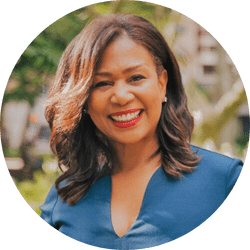As part of The Great Rethink, we focus here on the performing arts – digging into the unique challenges of these organizations, and how rethinking Workplace, Inclusion, and Value may benefit advancement teams in this sector. This arts roundtable features Marlah Bonner-McDuffie, Vice President of Development at the League of American Orchestras, Giuliano Kornberg, Executive Director, Sacramento Philharmonic & Opera, and our own Anne Johnson, Senior Vice President and Senior Consultant, who formerly served as Chief Development Officer for the San Francisco Symphony.
We look forward to the conversations and discussions that this article may spark. Serving the advancement needs of arts organizations is an important part of the work we do here at ALG, and we hope this piece will deliver practical insights that help advance the mission of our arts clients and partners.

Marlah Bonner-McDuffie is Vice President of Development for the League of American Orchestras. She began her career in the corporate sector, in the consumer brands and pharmaceutical industries. Her lifelong interests in arts and education led her to seek a career in the nonprofit sector for mission-driven organizations. Marlah has extensive experience leading all areas of philanthropy, strategic planning, marketing, and business development in the corporate and nonprofit sectors.

Giuliano Kornberg is the Executive Director at the Sacramento Philharmonic & Opera (SP&O), where he previously served as Chief Revenue and Development Officer. At SP&O he has worked with the Board of Directors, Executive Staff, and Consultants to create and implement the organization’s revenue-generating strategy. Giuliano’s effort in donor cultivation and stewardship helped double the Philharmonic & Opera’s Annual Fund, increase the Endowment and Planned Gift commitments by 50%, and helped ensure a balanced budget for the past four years.

Anne Johnson has brought her 25 years of higher education and non-profit fundraising experience to the benefit of many of America’s most influential artistic, medical, and educational institutions. Prior to joining Aspen Leadership Group, Anne served as chief development officer of the San Francisco Symphony, where she held responsibilities of both the senior management role and leadership of the Symphony’s contributed revenue division, while also working closely with the 80-member Board of Governors. Previously she served as Associate Vice President of Development for San José State University and Campaign Director for SJSU’s first-ever $200 million comprehensive campaign.
TOPIC: Within the arts – and the performing arts specifically – what do you think has been the biggest impact of this great rethink, and where is it headed? How is it impacting hiring and retention?
MBM: It’s interesting because we’re having many conversations about this now in my organization, and sometimes it can be a moving target. Just before the pandemic hit, we invested in a beautiful new office space, and we have been eager to get back to that space. During the pandemic, like everyone else, we were all remote. As soon as we were able to, we instituted a hybrid model consisting of two days a week in-office and what we call an ‘all-hands’ day on the first Tuesday of every month.
But as we continue to have discussions about the shifts the pandemic brought about in the workplace, and what our staff’s needs are, we continue to evolve. As we continue to think about the why of being in the office, we are becoming more intentional about the ways to maximize our productivity when we gather in-person as a team. We recently landed on not having any mandatory in-office days, and our “All-Hands” are now every other month. As a senior leadership team we are laser-focused on building strong culture, and we will continue to have conversations about how to meet the needs of our staff, while achieving optimal productivity.
In our goal of building a best-practice philanthropic shop, it is sometimes more important for us to be out in front, in-person, with donors than out in front with one another. And as we all know, we need to meet those high-capacity donors face-to-face. Building relationships in philanthropy not fully realized as a virtual experience. This entirely new ‘hybrid’ lane we’re in helps us be agile and being flexible in meeting donors in the ways they are most comfortable, but our priority is meeting in-person.
That said, I believe culture is a living, breathing thing. So even while we’re mostly remote, we’re very responsive to our teams and how they can be productive. There can be some sacrifices in collaborative productivity when you’re not working elbow to elbow with your team. But I would say that in addition to the challenges, there’s been some very significant upsides.
GK: We’re similar in that we don’t have a one-size-fits-all approach, but, like Marlah, my thinking on this is constantly evolving. Collaboration, ideating, and brainstorming are all so important to getting work done, and those opportunities can be hard to come by if you’re not all together in the office. But it’s important to remember that everyone’s human, and while there are days when people do their best work in the office interacting with colleagues, there are other days when sitting by yourself at your computer concentrating on a task could be done much better at home. As long as the work is getting done, the location is less important.
But as the leader of the organization, it’s incumbent on me to craft an environment where people are still interacting and being kept up to date. For a little while, we were kicking around the idea of mandatory core hours when everyone’s in the office, for staff meetings and the like. And that worked for a little bit. But what I found is that with the right plan in place, we don’t need it. We’re settling into a nice groove of consistently keeping everybody updated about what’s happening, whether they’re remote, or traveling, or working in the office.
Now, as a final note, I’d say that, it’s important for some staff and board members to live close enough to Sacramento to be here when needed. There are some positions, like box office for example, where it makes sense to have somebody spending more time in the office. That requires conversations, to explain why one role requires more time in the office compared to other roles. Just having the conversation helps those staff members understand the requirements of their role and not be jealous of other people who may spend more time working from home.
AJ: So how has that hybrid flexibility impacted the recruiting process, Marlah? It sounds like your staff are all in different locations, and maybe that wouldn’t have been how you would have structured it pre-pandemic, right?
MBM: No, I wouldn’t have structured the staff that way pre-pandemic. I actually hired two people this past year, one based in Ohio and the other based in Texas. I have one team member in New York and one in New Jersey. Our new VP of Learning & Inclusion is based in Detroit. And some staff who were based in New York City decided that they would move someplace else and work. So, we are increasingly national in our staffing, and it’s been great to make those decisions based on talent and skills, regardless of geography.
AJ: And that’s a completely different mode of operating.
MBM: It really is.
AJ: Has that hybrid and remote flexibility been a plus for you, Giuliano, in hiring people?
GK: Yes. We’ve been lucky that our most recent hires actually like being in the office, which is great. And I do think there’s a lot of benefit especially early on, even if it’s just for the first month or two, so you can interface with colleagues and leadership. But certainly as we continue to hire, what I am most concerned about is whether the work is getting done, and whether people are up to date on what’s happening throughout the organization.
AJ: Do you think that that would have been the same pre-pandemic, Giuliano?
GK: No. I think totally a result of the pandemic. Pre-pandemic there was just an automatic assumption that you got up, got dressed, and went into the office to do your work. You sometimes had meetings for the sake of having a meeting, talking about things everybody already knew. And time in the office wasn’t always the best use of time. The pandemic, which required everyone to be flexible, gave us an opportunity to assess what’s best for each individual team member and role. And now that we have the opportunity to come back to the office we need to ask: How are we going to come back?
This past season was difficult, getting back to a full slate of performances rapidly, as opposed to a gradual ramp-up. And I think that’s really important when considering where do people work and how did they get their work done. Because everyone is exhausted, and I could insist on coming back to the office only to find that people won’t stay. And that could lead to a lot of institutional knowledge walking out the door, all because they can get a similar work experience somewhere else while also working from home.
AJ: That’s a great point. From a recruiting perspective, we have definitely seen across all sectors, performing arts included, that candidates say they want more balance. They tell us, ‘I want to work for an organization I’m mission aligned with, but I want to go to my daughter’s dance recital, or my child’s soccer game. I’ve recognized through this pandemic that my values and priorities have shifted.’
So, it’s smart for performing arts organizations to really be thinking back to that retention question of, How I you get my staff to work really hard, do good work, and be successful, while also making sure they have a life?
And you know, Marlah, you said that as an organization, you haven’t necessarily tackled that. But I think that as a society, this whole pandemic has gotten us to rethink our priorities, our time, and our values. We can look at that as a silver lining in that it’s allowed people to focus with greater clarity on issues that they never had the opportunity or urgency to focus on before.
________________________
TOPIC: If you think about the unique challenges of performing arts organizations, have there been benefits, or drawbacks, specifically around Workplace flexibility – i.e., how you work, the effectiveness of the advancement team, and how successful they are in fundraising?
AJ: What’s always fascinating to me is that performing arts has never been a 9-to-5 job, even before the pandemic. You’re expecting your staff to be there – especially your fundraising staff or your operation staff – for concerts in the evenings, on weekends. So, even in the best of circumstances, they’re spending a lot of hours doing their jobs, well outside the traditional work-week.
And I’ve always thought that performing arts organizations needed to better think about schedules and expectations around start times and so forth, to take that into account. But now we’re turning that piece on its ear. It’s paramount that performing arts organizations take an even more flexible approach to people’s lives, schedules, priorities, and work-life balance.
It’s just as you said, Giuliano, you don’t want to lose good people. I’m in the business of helping you find good people, but I’m also hopefully, supporting you in retaining those good people because that retention is critically important. You don’t want to lose staff that you’ve trained so hard in your workspace.
MBM: I know that all too well. We were without development staff last year. We actually just did some analysis on just one chunk of the work, and it was glaring, the impact of a staff departures. We were able to make that work up, thankfully, in other places, but retention does have a significant impact. And it puts the burden on the remaining staff to sometimes work on tasks that are not a part of their role and often not the best use of skills and time.
GK: Those tasks not being the best use of your time.
MBM: Not at all. So, thankfully, now we are fully staffed. And our priority is retention. We invest a lot in recruiting, onboarding, and building those relationships. Your fundraisers carry all of your important fundraising relationships, so you don’t want that to be a revolving door. As nonprofits, we’re often not as competitive as other sectors. So if we can flex a little bit, then we flex.
GK: Agreed. I also have thoughts about the impact on our board. Throughout the pandemic, and now as we come out of it, we’ve had much greater flexibility for board meetings and development committee meetings. No longer do we have to gather at someone’s house at their dining room table, or at someone’s office, and deal with absenteeism, ‘Oh sorry, I can’t make it. Let me know how it goes.’
They could just call in, or Zoom in, and can get a sense of the organization’s top five or six donor prospects, and offer to help with calls if we need it. Or get an update on a specific program, or a task we’re trying to accomplish. They’ve just felt a little more connected. Pre-pandemic you could go months without talking to a board member, and when they drift away like that it takes a long time to bring them back.
So, actually, if I think about staff, board members, musicians, and so forth, I’ve seen the most movement actually from board members just because there is more of a flexible approach for keeping them involved. And for an organization our size, it’s hugely beneficial to have board members feel like they’re true partners. Because the more they feel involved, the more they’re willing to make that extra call or make that extra ask.
AJ: That gets back to the point Marlah made earlier about culture. You said it’s often more important and productive to spend time in front of donors than being together in an office. That’s a cultural issue for nonprofit organizations. Are either of you seeing any downside to not having the staff for example, be together more?
MBM: I want to be clear that I do think it’s important, when building a culture, that teams get together to forge strong relationships and be exposed to other workstreams and team members in the organization. But the pandemic and budget pressures have forced us all to prioritize high-impact activities that move donor relationships forward. If I schedule a two-hour meeting in the office staff can lose productive time commuting – time that could be spent prospecting, cold-calling, or some other activities that generate new business, or steward existing relationships. Where we are now, post-pandemic, we need to think long and hard about the purpose and focus of that in-person time. We need to ask, Why are we here? We need to make office time strategic and productive when we have those opportunities.
GK: Yes remote work can have its downside. For myself, if I’m not careful, I can easily work 12, 13, 14 hours a day, and that’s not good for me or anybody else. I actually did a little experiment where I compared responses to emails I sent late at night, versus scheduling them to go out first thing the next morning. Almost without fail, the tone and quality of the response was markedly better when emails were sent in the morning – as opposed to someone getting a late-night email and thinking ‘My boss is sending me an email at nine o’clock at night. It must be urgent. I better respond.”
So I don’t want people working until 6:00 or 7:00 at night unless they absolutely have to like for a performance or a rehearsal. We need to keep that in mind, because it’s just as easy to lose your work-life balance as it is to promote a work-life balance, when you’re working remotely and work is only a few feet away.
________________________
TOPIC: In this fluid Workplace model, particularly in the performing arts, what are the main skill sets you’re looking for that might ensure a candidate’s success?
MBM: First, I would say we hire for skill. Some things we can train for, because fundraising is absolutely both art and science. But there’s a lot of science, and candidates need to meet some very technical aspects of the role. We also look for drive, people who might not have a strong fundraising background, but bring strong determination to build and grow relationships. Whether that might be in a sales or client service role, I need to see that you have demonstrated relationship-building skills, instincts, and follow-through. And, at the League, there’s passion for the art form, for orchestras. These are some of the things I test for in the interview process.
As for the possibility of hybrid and remote work, it was absolutely a plus. One of our hires is based in Texas, and one is in Ohio, and our headquarters are in New York. Both have adapted quickly to the demands of their roles even while mostly remote. Both are proactive about the needs of staying connected to our team and getting out in front of donors.
GK: Certainly skill, drive, and passion, but also I would add initiative. With flexibility, staff have to accept more autonomy over their work. Whatever role they’re in – front-facing toward donors and external constituencies, or working in the back-office keeping the trains running on time – they need to be fully invested in their role, and show the motivation necessary to deliver on their piece of the mission.
In that way, recruiting has to balance the needs for the specific role and department, with the character traits of the candidate – i.e., how and where they work best, and what kind of work they are best suited for. I’ve found that when you lay out the requirements of the role, especially when it comes to public-facing responsibilities versus more internal roles, candidates appreciate knowing exactly what they’re getting themselves into.
But I’d add that performance is the key factor in the Workplace decision. For example, if you prefer to work from home, but I see that you do better work in the office, then that’s where you should probably be spending most of your work time. If the work is getting done at a high level, then we can talk about flexibility, but it needs to be done at a high level. Otherwise, what good does it do? You’ve got to perform. And I think that’s fair for everybody.
AJ: The only other point I’d add is ‘mission.’ The first question I ask every candidate in every search is, Why do you want this position with this specific organization? There has to be passion for the mission, a reason why they truly want to work for this particular organization versus the dozen others they might be applying for. And I need to really understand that’s where they want to be, for them to be successful candidate. So that certainly drives the recruiting process.
It also gets back to the retention issue. If you’re passionate for the performing arts and that’s where your heart is, it’s going to make the long hours and the weekends and the evenings much easier. It’s going to be pretty painful if you’re giving up your nights and weekends for an organization you don’t really feel truly aligned with. So yes, I think a sense of mission is absolutely critical for success, especially in a world of hybrid/remote work where staff are given more autonomy and empowered to work where they work best.
Curious to learn more? Read the next article in our series here.



